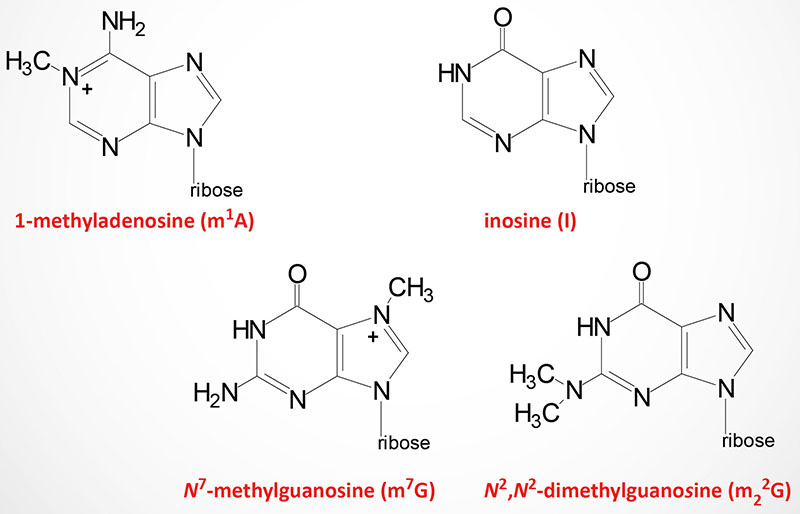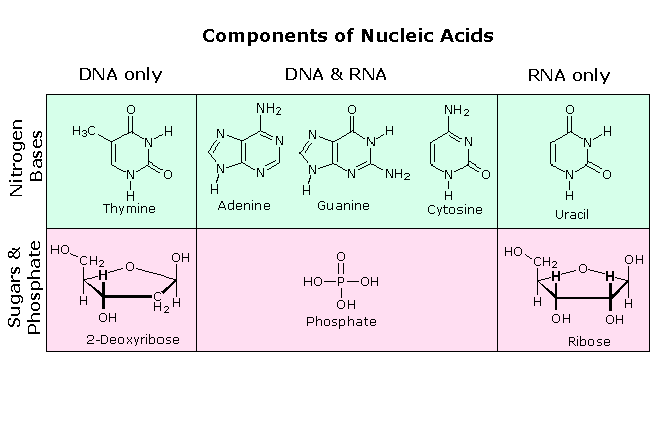All Nucleic Acids Must Contain Which of the Following
They are composed of nucleotides which are the monomers made of three components. Adenine and guanine are classified as purines.
Both contain a pentose sugar.

. They contain all the structures mentioned in all the options of the question. Up to 10 cash back Nucleic acids are made up of nucleotides that contain a pentose sugar a phosphate group and a nitrogenous base. DNA and RNA structure.
Nucleic acids DO NOT contain evanlance69 evanlance69 05042017 Biology High School answered All BUT one of the following is a component of nucleic acids. All nucleic acids must contain which of the following. Thesis Help Human Anatomy All nucleic acids must contain which of the following.
As they have a nucleus nucleic acid organelles cytoplasm and a membrane. Which nucleic acid DNA or RNA contains each of the following components. Nitrogenous base which is either a pyrimidine one ring or a purine two rings 2.
Adenine guanine cytosine and uracil U rather than thymine. Biology is brought to. C The bases in nucleotides are attached to a pentose sugar moiety by a glycosidic linkage.
What components do all nucleic acids both DNA and RNA contain. A 5-carbon sugar a phosphate group and a nitrogenous baseThe two main classes of nucleic acids are deoxyribonucleic acid DNA and ribonucleic acid RNA. Nucleotides have a distinctive structure composed of three essential components which are covalently linked together.
If the sugar is ribose the polymer is. DNA has deoxyribose whereas RNA has ribose sugar residues. Nucleic acids DO NOT contain 2.
It is in the nucleus of eukaryotes and in the organelles chloroplasts and mitochondria. D The sugar molecule of the nucleotide is in L-configuration. A nucleic acid is held together by the sugar-phosphate complex.
Nucleic acids are biopolymers macromolecules essential to all known forms of life. DNA is the genetic material in all living organisms ranging from single-celled bacteria to multicellular mammals. The outside of the DNA structure also includes phosphorus.
Nucleic acids are composed of nucleotides. Amino acids link together to form a protein. A Sugar component of a nucleotide is ribose.
All food does contain nucleic acid as that is the basis of DNA which is in all living things. A general characteristic of nucleic acids is that they are A very small simple molecule B a combination of inorganic and organic compounds C all composed of building blocks called nucleotides D a type of inorganic compound E used as biological catalysts. Nitrogen bases form the backbone of a nucleic acid.
The primary structure of a purine is two carbon-nitrogen rings. 2 Which of the following statements is true. Molecular structure of RNA.
A single polynucleotide chain. There are two types of nucleic acids. Some components may be found in both DNA and RNA Components Ribose Deoxyribose Thymine Phosphate Adenine Single polynucleotide strand Nucleotide GMP Nucleotide dCMP Double helix Uracil DNA RNA.
DNA contains each of the following components except _____. Nucleotides link together to form a nucleic acid. ATP NAD Nucleotides without phosphate groups Which of the following ALWAYS contain the elements C H O N.
They have nucleic acid inside the Nucleus 2. Which element has the nuclear configuration of 126. Phosphate groups Nitrogenous bases Nucleotides 5-carbon sugars Deoxyribonucleic acid Which molecules function in a cells energy metabolism.
Click here to get an answer to your question All BUT one of the following is a component of nucleic acids. All nucleic acids must contain which of. Adenine A guanine G cytosine C and thymine T.
Of the following which represents an organic compound. The two main types of nucleic acids are deoxyribonucleic acid DNA and ribonucleic acid RNA. Select all that apply.
Are attached through a phosphate to hold the strands together. DNA uses thymine while RNA uses uracil. DNA uses deoxyribose while RNA uses ribose.
The main difference between these cells from the prokaryotic cells is that they do not have membrane-bound organelles. Select all that apply. B Sugar component of a nucleotide is deoxyribose.
The difference between these two nucleic acids is their pentose sugar. A protein is held together by the carbon-carbon bonds. Are held together by hydrogen bonds.
In prokaryotes the DNA is not enclosed in a. Up to 10 cash back DNA and RNA differ in the nitrogenous bases used in their nucleotides. Nucleotides are the building blocks of both DNA and RNA.
The two strands making up the DNA double helix molecule. This is the currently selected item. Nucleic acids do not contain amino acids.
Contain ribose and deoxyribose in opposite strands. All paper formats APA MLA Harvard ChicagoTurabian Font 12 pt Arial Times New Roman. The structure of the bases also includes common organic atoms such as carbon oxygen and hydrogen.
Another name for Nucleic acids are also called nitrogen bases. Both nucleic acids are joined into polymers by phosphodiester bonds and use adenine as a nitrogenous base. Do many food substances contain nucleic acids.
RNA nucleotides also contain one of four possible bases. Each nucleotide in DNA contains one of four possible nitrogenous bases. Peptides form the backbone of a protein.

Dna Vs Rna 5 Key Differences And Comparison Technology Networks

Biochemical Properties Of Nucleic Acids The Medical Biochemistry Page


Comments
Post a Comment